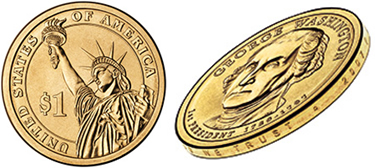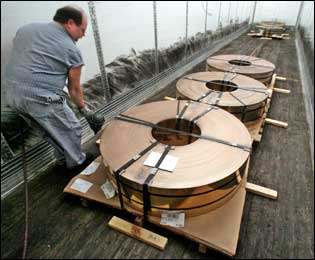The Presidential Dollars
Golden Collectibles or the Next Coin of the Realm?
They're attractive, and they're actually quite convenient once you get used to them.
The U.S. Mint is betting it's got it right this time. On February 15 ― just in time for Presidents' Day ― the Mint placed into circulation the first of its new golden dollar coins featuring, for the initial issue, George Washington. George probably wouldn't have approved, since he disliked King George III's practice of stamping his coinage with royal images. No matter, since "Washington" dollars will only be issued for three months, after which it will be John Adams' turn for a quarter-year, followed by Thomas Jefferson, James Madison, and so on through the remaining presidents until 2016. The reverse sides of the coins will all display an image of the Statue of Liberty ― different for each president. The edges will contain the words "E Pluribus Unum" and "In God We Trust," plus the year of issue and the mark of the issuing mint.
 The first four presidential golden dollars. The new manganese brass coins will be issued quarterly in the order of the presidents' terms.
The first four presidential golden dollars. The new manganese brass coins will be issued quarterly in the order of the presidents' terms. The coins' reverse feature an image of the Statue of Liberty, while the edges are embossed with the words 'E Pluribus Unum,' 'In God We Trust,' the year of issue and mintmark.
The coins' reverse feature an image of the Statue of Liberty, while the edges are embossed with the words 'E Pluribus Unum,' 'In God We Trust,' the year of issue and mintmark.The rules set down by Congress stipulate that presidents honored on the new coins must have been dead for two years before "their" dollar is struck, and that coins will be issued in the order the presidents served, no matter how long (or short) that might have been. William Henry Harrison therefore gets one issue over three months, despite the fact that he spent barely a month in office. Franklin Delano Roosevelt gets one for his three-plus-a-fraction terms. But Grover Cleveland gets two, since his terms were non-consecutive. Those are the rules.
The Mint believes that the sequential releases will make the new dollars a success, basing its projections ― some say its hopes ― on the 125 million Americans who dutifully stash away a few "state" quarters for the grand kids each month. (By any measure, the state quarter program is an enormous success.) By contrast, the Eisenhower dollar (introduced in 1961), the Susan B. Anthony (1979) and the Sacagawea (2000), which didn't have that collect-the-entire-set appeal going for them, flopped. Somewhere, in a repository that must resemble Scrooge McDuck's vault, hundreds of millions of those unwanted dollars are gathering dust. The Sacagawea is still being minted, albeit in small quantities.
Thus far, the Mint's plan is working. The new dollars seem to be catching on, if not for widespread commerce (which would require taking the dollar bill out of circulation, something Congress didn't do), then at least for collection. And we're talking about some sizeable numbers here: The Federal Reserve, the Mint's distribution agent, has placed orders for 300 million of the Washington coins alone. They haven't yet said whether less-renowned presidents than the first four will be granted such largesse down the road, but if sales are brisk, anything could happen.
That would be good news for copper. Those 300 million Washingtons amount to 5.4 million pounds of a special brass alloy containing 4.74 million pounds of copper, and that's just for a three-month supply! Not to worry, we won't run out of the red metal. In 2005, the U.S. consumed 5.2 billion pounds of refined copper and another 2 billion pounds of recycled copper scrap. And, despite all you read about copper costing $3 a pound give or take, it will cost Uncle Sam only about 20 cents to make each new coin, for which we the people pay a buck.
Yes, the mint actually makes a profit on the coins, which is nothing new. It's called seigniorage, and all governments have always done it. In fact, it's one reason the mint sees dollar coins as a good thing. (It's especially good for the government's coffers if, as expected, people squirrel many of the coins away.) Another factor in the coins' favor is that they'll probably be in circulation for more than 20 years. Dollar bills cost less to produce but must be replaced every 18-22 months, thus costing the government more than coins over time.
A team of metallurgists at Olin Brass's venerable Metals Research Laboratories in New Haven, Connecticut, developed the manganese brass used in the new coins, and in the Sacagawea dollar before it. (Brasses are those copper alloys whose major secondary alloying element is zinc, which, in this case, comprises 12% of the coin alloy by weight.) The alloy also contains 7% manganese, a metal used to harden several other brasses, and 4% nickel, which imparts corrosion resistance and is used in all other U.S. coins as well as those in many foreign countries. As does the Sacagawea, the new dollar precisely matches the weight, size and electronic signature of the Susan B. Anthony.
 Manganese brass strip manufactured at Olin Brass's mill is prepared for shipment to the Denver Mint.
Manganese brass strip manufactured at Olin Brass's mill is prepared for shipment to the Denver Mint.Olin Brass produces the alloy in East Alton, Illinois, where strips of the metal are pack-rolled over and under a layer of pure copper. Like dimes and quarters, the new golden dollars are actually sandwich structures. In this case, the inner, copper layer accounts for 50% by weight of the coin. The copper layer makes up only 33% of the weight of dimes and quarters, whose outer layers are made from a copper-nickel alloy. Given its thicker copper core, the golden dollar overall contains 88.5% copper, 6.0% zinc, 3.5% manganese and 2% nickel.
The Mint selected PMX Industries, Inc., Cedar Rapids, Iowa, as a second source for the manganese brass strip based on the company's experience with similar products. PMX is a world-class supplier of copper alloys. Its modern mill in Cedar Rapids is the first such facility to be built in the USA in fifty years. Among the company's many products are strip alloys used in computer-chip lead frames and other electronic devices, jewelry and, of course, coins, including "conventional" U.S. denominations.
Will the new dollars catch on? Here's a quick test you can run: buy a few at your local bank (the Fed saw to it that the coins it bought were widely distributed), then pass them around when you're shopping, or maybe tip your hairdresser or barber. Then watch for the reaction. We think the Mint is on to a winner this time. ![]()
Also in this Issue:
- The Presidential Dollars
